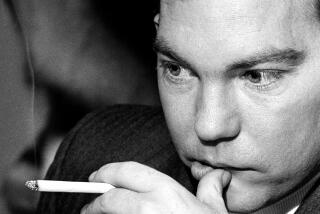2 Survivors Can’t Forget Horror of Pol Pot
PHNOM PENH, Cambodia — As much as he would like to, artist Vann Nath can’t forget the face of Pol Pot, the Cambodian leader under whose capricious rule he was tortured and almost killed.
That’s because Pol Pot’s face saved his life.
Vann Nath was due to be sent to Cambodia’s “killing fields” along with nearly 20,000 others who were held at Tuol Sleng Prison during the Khmer Rouge leader’s reign of terror two decades ago. But he suddenly was spared to paint Pol Pot’s portrait.
When the despot’s rule ended in 1979, Vann Nath was one of only seven prisoners who had survived.
Farmer Him Huoy, meanwhile, can’t escape the shadow of Pol Pot. A soldier who was assigned as a guard and driver at Tuol Sleng, it was his job to make the lists of those condemned to death, drive them to the killing field, then verify that they had been “smashed.”
Because his signature was on the notorious death lists, he is still haunted by the role he says he played out of resignation and fear that he too would be killed if he disobeyed.
Two weeks ago, for the first time in the 18 years since the elusive Khmer Rouge leader disappeared into Cambodia’s jungles, Pol Pot was spotted by outsiders in his jungle camp--deposed, ailing and sentenced to life imprisonment by his former comrades.
Though Pol Pot left behind voluminous files documenting the policies that left more than 1 million Cambodians dead due to starvation, illness or execution, few witnesses to the workings of his morbid bureaucracy remain to testify if he is ever brought to an international tribunal.
Vann Nath and Him Huoy, prisoner and guard, both servants and victims of the cruel ruler, are two of the few left to tell the tale of his maniacal but methodical genocide of people he imagined to be his enemies.
“I know Pol Pot better than anyone,” said Vann Nath, 52, lean and white-haired, sitting in his Phnom Penh home. “I know this man through his face. He is a professional killer, a monster.”
In 1978, Vann Nath was swept up in a wave of arrests of people considered to be enemies of Pol Pot’s radical movement to turn Cambodia into an agricultural utopia. The arrests started with political foes, then expanded to include intellectuals, landowners, “informants” and spies--even people who simply wore glasses were arrested because they looked like intellectuals.
Vann Nath said he doesn’t know what crime he is supposed to have committed. “They arrested nearly everyone in my village,” he said, shrugging.
He was brought to a Phnom Penh school compound converted into a prison, a site called “S-21” or “Tuol Sleng” but known by neighboring factory workers as “the place where people go in and never come out.”
There, he was shackled by the ankles to the cement floor of a cell, in a row with dozens of other prisoners, and fed only a few spoons of rice each day. Each prisoner was forced to write a “confession,” admitting treason and naming other spies or enemies, who in turn were arrested and interrogated. Nearly every prisoner was executed under direct orders from Pol Pot.
One day, Vann Nath said, guards walked into his crowded cell and asked for “the painter.” They carried him to an office and showed him a picture of Pol Pot and asked if he could paint the leader’s portrait.
“I was not really sure what I should say,” Vann Nath recalled. “I said, ‘Right now, I can’t even stand up.’ ”
From then on, he received enough food to give him the energy to paint and began what he describes as a special kind of torture. Every day, from sunrise until midnight, he would work on head-and-shoulders oil paintings of Pol Pot--”the same portrait, over and over again,” he said.
All day, as he painted, he could hear the screams of people being tortured under Pol Pot’s orders to smash the enemies of the Khmer Rouge, real or imagined.
“I hated him while I was painting him,” Vann Nath said. “I wished I could kill him.”
Instead, he was trapped in the act of his creation, forced every day face to face, eye to eye with Pol Pot’s looming visage.
“Oh, these are bad memories,” he said, rubbing his palms together as if scrubbing away stains of recollection.
In December 1978, after Vann Nath had been at Tuol Sleng for nearly a year, Vietnamese soldiers invaded Cambodia and soon drove Pol Pot into the jungle. Cambodian guards took the prisoners away to be killed but met Vietnamese soldiers on the way. While the guards and soldiers fought, Vann Nath and six other prisoners escaped.
Today, Tuol Sleng Prison has become the Genocide Museum. The walls are covered with thousands of black-and-white photographs of men, women and children documented on their way to the killing fields.
In Pol Pot’s meticulous “bureaucracy of death,” each person was photographed with a number, the tag sometimes safety-pinned directly to their skin. More than 4,000 written “confessions” remain to record the quotidian acts considered capital crimes in the final paranoid days of Pol Pot’s regime: hoarding rice, criticizing one’s neighbors, going out for a drink.
In each of the museum’s buildings hang Vann Nath’s contributions to history as a witness to the systematic torture and execution of Pol Pot’s victims. He painted images of acts he witnessed or heard described while in prison: electric shock treatment, water torture, a naked man trussed upside-down to a pole like an animal being carried to the slaughterhouse.
There is a haunting self-portrait of Vann Nath, bearded, emaciated and despairing in his tiny cell. “I was just a body then,” he said. “My spirit had gone out.”
Today, he owns a large house and a restaurant, and lives quietly in Phnom Penh. There are no paintings on his bare white walls; he has hardly picked up a brush since his last “torture” series, though he says he may build a small studio and start painting again.
Vann Nath speaks quietly and resists talking about the thousands of families he saw brought in to Tuol Sleng, interrogated, then taken away.
But he says he has a duty to history and to Cambodia’s future.
“My hope is to bring Pol Pot to justice. I would testify in court about what I saw. So far, I haven’t been able to find the word to describe the killing during his reign. ‘Atrocity’ is not big enough for all the people he killed.”
Meanwhile, about two hours outside of Phnom Penh, down a bumpy dirt road meant more for cows than cars, farmer Him Huoy, 42, lives in a wood-and-bamboo house on stilts. The ground is carpeted with harvested red chili peppers drying in the sun.
Although his wife and seven children, his relatives and most of the village know parts of his past, he climbs up the ladder and retreats into the dark interior of his house to tell his story.
In early 1978, he begins, 200 soldiers from his unit, Unit 703, were transferred to be guards at Tuol Sleng. “It was a terrible place. Everybody, including the guards, thought they were doomed. No talking was allowed; my job was to ask the name of the prisoner, that’s all. Sometimes, the people would ask me why they had been sent there. I replied, ‘What mistake did you make to get sent here?’ I asked myself the same question.”
Him Huoy looks over his shoulder to ensure that none of his children are within earshot as he describes the mechanics of extermination.
After they drove trucks carrying about 30 prisoners each to the killing fields outside Phnom Penh, he would “check their names, one by one, and check that the graves are ready.”
There were special days for killing only women and children.
“One by one, the prisoners sat by the well, bent their heads and were hit on the neck with an iron bar,” he said. “Then a second man would kill them with a knife and throw them into the well. I saw this with my own eyes, and I was afraid.”
As the Khmer Rouge began to turn on itself, even his fellow guards began to appear on his list. “Everyone was worried about themselves,” he said. “Everyone worried it would be him next. Even the chief of the prison, a man named Dheuk, and his deputy distrusted each other and tried to catch each other’s mistakes.”
Prison records show that about 60 of 200 prison staff members were killed--including the deputy.
When the Vietnamese overran the Khmer Rouge in the area in December 1978, some of the soldiers and guards were flown to the Thai border to escape. “Some went to Thailand, some went to America,” Him Huoy said. “But I wanted to go back to my village.”
After he returned home, he did not tell anyone what he had done and seen; in 1981, he married a woman from his village. A year after their wedding, police showed up at his door and accused him of running Tuol Sleng Prison because of his signature on the death lists. He proved that he was just a worker, but he was sent to jail as a war criminal.
The village shunned him when he got out of jail. But one morning, an old woman fell into the river and Him Huoy leaped in and saved her. That act made him a small hero in the village and redeemed him from his past.
“If I really were an evil man, I would have let her drown,” he said. “Now they don’t dislike me. I am invited to all the ceremonies and festivals.”
If Pol Pot were brought to trial, Him Huoy said that he would testify about the chain of command and the horrible deeds done in the name of “Brother No. 1” or “The Organization,” as the leader and his cadre were known.
Him Huoy said he met Pol Pot once, and in Tuol Sleng saw the manifestation of his madness. Some revered the leader, all feared him, but Him Huoy said he doesn’t understand him. “Pol Pot won the battle,” he said. “Why did he keep on killing?”
More to Read
Sign up for Essential California
The most important California stories and recommendations in your inbox every morning.
You may occasionally receive promotional content from the Los Angeles Times.










